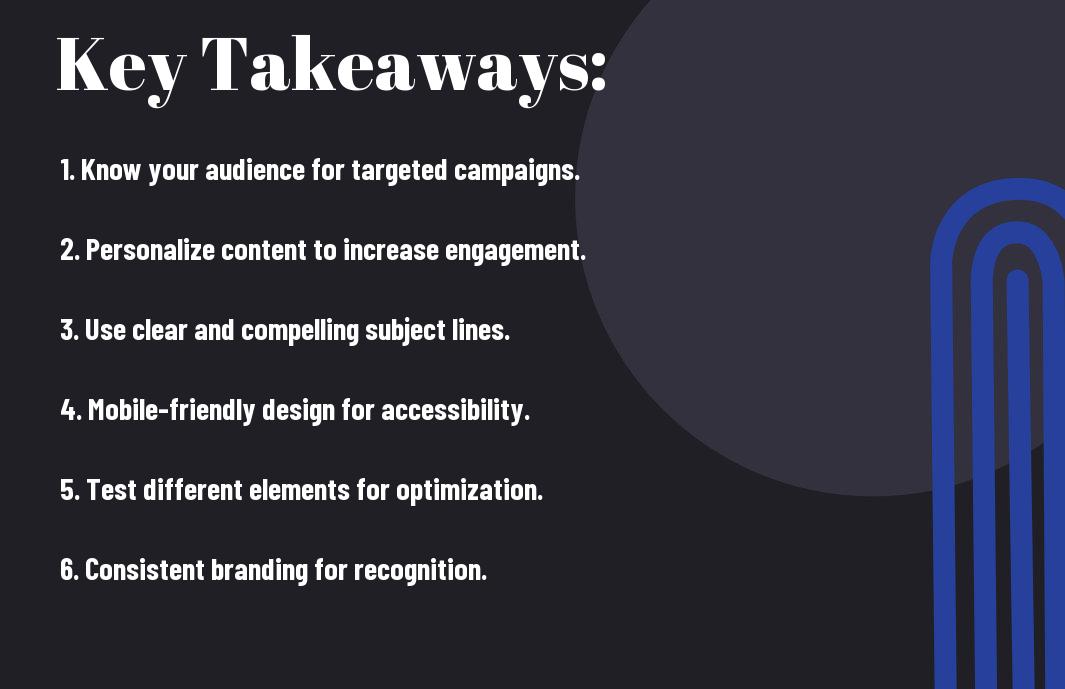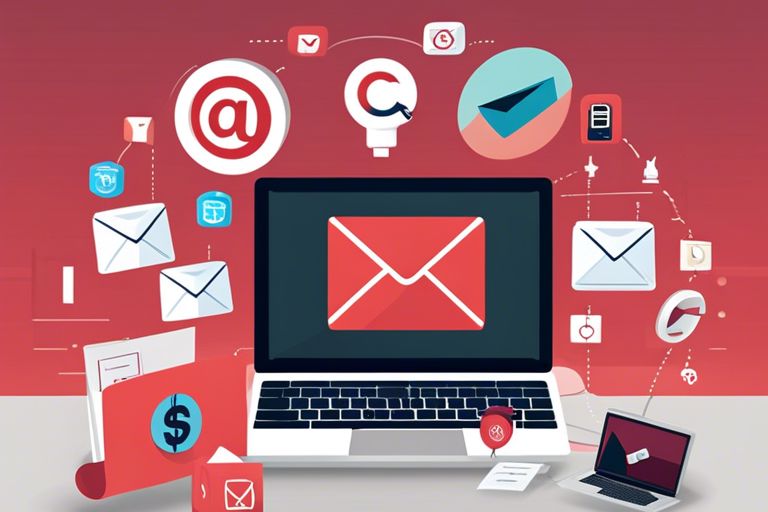There’s no denying the power of email marketing when it comes to reaching and engaging with your audience. With over 3.9 billion active email users worldwide, a well-executed email campaign can be a game-changer for your business. To ensure you make the most of this valuable marketing tool, it’s crucial to follow these 10 best practices for successful email marketing campaigns. From crafting compelling subject lines to segmenting your audience and analyzing your data, these tips will help you maximize your email marketing efforts and achieve impressive results for your business.
While you are here check out this episode of the Dark Horse Entrepreneur Podcast entitled: Maximize Your Inbox: 10.5 Key Email Marketing and Life Lessons
Key Takeaways:
- Personalization: Tailoring emails to individual recipients increases engagement and response rates.
- Mobile Optimization: Ensure emails are mobile-friendly to reach a larger audience who primarily use smartphones to check emails.
- CTA Placement: Clear and prominent call-to-action buttons help drive conversions and achieve campaign goals.


Building Your Email List
Effective Opt-in Strategies
For successful email marketing campaigns, building a robust email list is crucial. Generating an organic email list through effective opt-in strategies ensures that your emails reach engaged and interested recipients. Offer valuable content, exclusive deals, or a free resource in exchange for email subscriptions. Make your opt-in forms prominent on your website and social media platforms to capture leads effectively.
List Segmentation for Targeted Campaigns
With list segmentation, you can divide your email subscribers into smaller groups based on demographics, behaviors, or interests. This allows you to target your audience more effectively and send personalized content that resonates with them. By segmenting your list, you can improve engagement, open rates, and ultimately, conversion rates. Create tailored campaigns for each segment to maximize the impact of your email marketing efforts.
Your email list is the lifeblood of your email marketing strategy. It is crucial to continuously grow and maintain a quality list of subscribers who are genuinely interested in your brand. Engage with your subscribers regularly, provide valuable content, and keep your list updated by removing inactive or unengaged subscribers to ensure optimal deliverability and engagement rates.
Crafting Your Message
Creating Compelling Subject Lines
For an effective email marketing campaign, the subject line is the first impression your audience will have of your message. It is crucial to craft a compelling subject line that captivates the reader and entices them to open the email. Keep it concise, clear, and relevant to the content of your email to increase open rates.
Design and Content Considerations
Design and content play a significant role in the success of your email marketing campaigns. Design your emails with a visually appealing layout that aligns with your brand’s identity. Ensure that the content is engaging, informative, and personalized to resonate with your target audience. Use visuals strategically to enhance the message and include a clear call-to-action to drive conversions.
Campaign Execution
Timing and Frequency of Emails
After crafting a compelling email marketing campaign, it is crucial to consider the timing and frequency of your emails. Timing is key when it comes to engaging your audience. Sending emails at the right time can significantly impact open and click-through rates. Additionally, be mindful of the frequency of your emails. Bombarding subscribers with too many emails can lead to unsubscribes and a negative brand perception. Find a balance that keeps your audience engaged without overwhelming them.
Testing and Optimization Strategies
Campaign testing and optimization strategies are vital for the success of your email marketing efforts. Before launching a campaign, it’s crucial to test elements such as subject lines, visuals, and call-to-action buttons to optimize performance. A/B testing can help determine what resonates best with your audience and improve your overall campaign effectiveness. Make sure to regularly analyze and optimize your campaigns based on these insights to continuously improve results.
Analyzing Results
Measuring Campaign Performance
All successful email marketing campaigns rely on data for optimization and improvement. By analyzing results, you can determine which strategies are working well and which ones need adjustment. Metrics such as open rates, click-through rates, conversion rates, and unsubscribe rates provide valuable insights into the effectiveness of your campaigns.
Adjusting Tactics Based on Data
The success of your email marketing campaigns hinges on your ability to interpret and act on the data gathered. By closely monitoring key performance indicators, you can identify trends and patterns that can guide your decision-making process. This data-driven approach allows you to identify strengths and weaknesses in your campaigns and make necessary adjustments to improve overall performance.
For instance, if you notice that a particular subject line consistently generates high open rates, you can replicate this strategy in future campaigns. On the other hand, if a certain call-to-action fails to drive engagement, you can experiment with different approaches to see what resonates with your audience. Regularly analyzing your data and making informed decisions based on the results is crucial for the success of your email marketing efforts.
Maintaining Subscriber Relationships
Despite the ever-evolving landscape of digital marketing, email remains a powerful tool for businesses to engage with their audience. Maintaining strong subscriber relationships is crucial for the success of any email marketing campaign. Here are some best practices to ensure that your subscribers remain engaged and responsive to your emails.
Ensuring Subscriber Engagement
Ensuring subscriber engagement is vital for the success of your email campaigns. To keep your subscribers interested, make sure to personalize your emails, send relevant content, and provide value with each communication. Encourage feedback and interaction by including surveys, polls, or invitations to connect on social media. Engaging your subscribers will help build a loyal customer base and increase the effectiveness of your email marketing efforts.
Dealing with Unsubscribes and Bounce Rates
Dealing with unsubscribes and bounce rates is an inevitable part of email marketing. While it may be disheartening to see subscribers opt-out of your emails or encounter bounce-backs, it’s crucial to handle these situations gracefully. Monitor your unsubscribe and bounce rates regularly, and make sure to clean your email list periodically to maintain its quality. Use the insights gained from these metrics to refine your email marketing strategy and improve subscriber engagement.
Understanding the reasons behind unsubscribes and bounce rates can help you identify areas for improvement in your email campaigns. Whether it’s a lack of relevance in your content, sending emails too frequently, or using outdated email lists, addressing these issues promptly can help reduce unsubscribe rates and bounce backs.
Leveraging Advanced Techniques
Now, to further enhance your email marketing campaigns, it’s vital to leverage advanced techniques that can set you apart from the competition. For more comprehensive insights, check out our 10 Email Marketing Best Practices and Strategies.
- Automation and Drip Campaigns
- Personalization and Dynamic Content
Automation and Drip Campaigns
Leveraging automation and drip campaigns can significantly increase the efficiency and effectiveness of your email marketing efforts. By setting up automated workflows triggered by specific actions or time intervals, you can ensure timely and relevant communication with your subscribers. This approach not only saves time but also allows for personalized messaging based on individual preferences and behaviors.
Personalization and Dynamic Content
On the forefront of successful email marketing campaigns is the implementation of personalization and dynamic content. It’s crucial to tailor your emails to resonate with each recipient on a personal level. This means going beyond simply addressing them by name and incorporating dynamic content that adapts based on their past interactions with your brand. By creating a customized experience for each subscriber, you can significantly improve engagement and conversion rates.
Legal Compliance and Best Practices
Understanding GDPR and CAN-SPAM
Many businesses often overlook the importance of legal compliance when executing email marketing campaigns. With the implementation of GDPR (General Data Protection Regulation) in Europe and CAN-SPAM Act in the United States, it is crucial for businesses to understand the regulations and requirements set forth by these laws to avoid hefty fines and maintain a good reputation with customers.
Email Marketing Ethics and Deliverability
To ensure the success of your email marketing campaigns, it is crucial to maintain high ethical standards and focus on deliverability rates. To maintain a positive sender reputation, businesses should avoid purchasing email lists, sending misleading content, or engaging in spammy practices. By following ethical guidelines, businesses can improve their email deliverability rates and engage with their audience effectively.
Understanding the regulations and best practices surrounding email marketing is crucial for businesses looking to run successful campaigns. By prioritizing legal compliance, ethical practices, and deliverability, businesses can not only avoid legal repercussions but also build trust with their audience and improve their email marketing ROI.
The Future of Email Marketing
Emerging Trends and Technologies
To stay ahead in the ever-evolving landscape of email marketing, it is crucial to keep a close eye on emerging trends and technologies. Artificial intelligence, machine learning, and automation are shaping the future of email marketing, enabling marketers to personalize content, optimize send times, and improve overall campaign performance. Interactive emails, AMP for Email, and increased mobile optimization are also trends to watch out for as they enhance user experience and engagement.
Integrating Email with Other Marketing Channels
Integrating email with other marketing channels is becoming increasingly necessary for a cohesive and effective marketing strategy. Combining email with social media, content marketing, and personalization can amplify your reach and engagement with customers. By syncing your email marketing efforts with other channels, you can create a unified brand experience and improve customer loyalty. Utilizing data analytics and automation tools across channels can provide valuable insights for targeted campaigns and improved ROI.
Conclusion
The 10 best practices for successful email marketing campaigns outlined in this guide are tried and tested strategies that can help businesses effectively engage with their audience, drive conversions, and ultimately grow their business. By implementing these practices, businesses can ensure that their email campaigns are optimized for success and resonate with their target audience. Bear in mind, consistency, personalization, and relevant content are key components of a successful email marketing strategy. Keep these best practices in mind when planning and executing your next email campaign to boost your results and achieve your marketing goals.
FAQ
Q: What are the key components of a successful email marketing campaign?
A: The key components of a successful email marketing campaign include building a high-quality email list, crafting compelling subject lines and content, designing responsive and visually appealing emails, personalizing content based on user behavior, and measuring and analyzing campaign performance.
Q: How can I improve the open and click-through rates of my email campaigns?
A: To improve open and click-through rates, you can segment your email list based on user demographics and behavior, A/B test subject lines and content, optimize send times, ensure emails are mobile-friendly, and include clear call-to-action buttons that drive engagement.
What are some best practices for maintaining a positive sender reputation?
A: To maintain a positive sender reputation, you should use double opt-in methods to build your email list, avoid using spam triggers in your subject lines and content, regularly clean your email list to remove inactive subscribers, and comply with anti-spam regulations such as CAN-SPAM and GDPR.
Great blog. Very useful content!
Thank you. Let me know if there is a topic you’d like me to write more about.
Very informative article.
thank you! Which part did you find most informative?